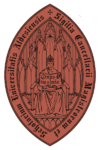University of Aldesey/Draught
 Seal of the University of Aldesey | |
| Latin: Universitas Lendartiensis apud Aldesiam | |
| Type | Public |
|---|---|
| Established | September 29, 1256 |
| Founder | Edmund IV |
Religious affiliation | Church of Nortend |
| Endowment | £100 million |
| Chancellor | Lord Bishop of Chepingstow |
| Vice-Chancellor | Martin de Hazels |
| Rector | Thomas Matthews |
| Students | 9,000 |
| Location | , |
| Languages | English, Latin, Greek |
| Colours | |
The University of Aldesey, formally the Chancellour, Masters and Scholars of the University of Lendert at Aldesey (Latin: Universitas Aldesiensis or Chancellarius, Magistri et Scholares Universitatis Lendartiensis apud Aldesiam) is an ancient collegiate university in Great Nortend located in Lendert-with-Cadell. To-day, the University consists of four faculties, eight schools and twenty four houses with a broad academic focus on the liberal arts. In 2018, there were around 9,000 students studying at the University. Graduates of the University occupy an exclusive and prestigious place in Erbonian society, forming the majority of lawyers, physicians, clergymen, academics, politicians, nobility, military officers, senior civil servants and schoolteachers.
History
It developed out of the monastic school of Lendert Abbey in the 10th and 11th centuries. In 1256, Edmund IV granted a charter to establish a university in Lendert to the Lord Bishop of Chepingstow, who held ordinary jurisdiction over the city until the creation of the see of Lendert. Instead of its original location in the close of the Abbey, the new University of Lendert settled on Aldesey, which was then a small village upon two islands in the Wessert to the west of the main city. Non-monastic scholars were prevented from living at Peterhall, and instead attached themselves to the parish church of St. Mary the Virgin, whose rector obtained a charter in 1264 to form Ladyhall.
Sampser Reforms
In the 19th century, it was increasingly recognised that the University was failing to advance learning and science, especially in the arts. In particular, the lack of further formal courses of study in the arts resulted in the University's declining importance in the burgeoning fields of natural philosophy and history. Lord Sampser was appointed in 1878 by Parliament to undertake a wholesale reform of the University, leading to the publication of the Sampser Report which recommended the establishment of the degrees of Bachelor and Doctor of Science and of Letters within the Faculty of Arts which occured in 1883 with the passage of the University Act. Furthermore, the practice of termly written examinations was formalised, among other sundry reforms.
Organisation
The University consists of the four faculties, being those of Arts, Laws, Medicine and Divinity. Within the Faculty of Arts are the sub-faculties of Letters and Science, the former consisting of the schools of Languages, Music, Philosophy and History, and the latter the schools of Mathematics, Astronomy, Natural Philosophy (Physics and Chemistry) and Natural History (Biology and Geology). Unusually, the Faculty of Laws includes the schools of Economics and Politics, as well as the schools of Civil Law and Canon Law.
The formal corporate body of the University is known as the Great Congregation, comprised of all masters of the University, who are all Masters of Arts or are otherwise a Doctor of Science, Letters, Music, Physic, Laws or Divinity. The Congregation has a role in passing University's statutes and regulations, subject to the Chancellour, as well as having control over academic matters such as examinations, rustication, matriculation, the curriculum and lectures, as well as granting graces, dispensations and degrees. The Congregation, with its large size, normally meets every three years, and delegates its powers to the smaller Lesser Congregation, or Convocation of Regent Masters, who have power over academic matters. Statutes are deliberated upon by the Convocation, and if agreed to, referred back to the entire Congregation.
Parallel to the faculties are the twenty four houses—either colleges or a halls—which are structurally independent of the University and responsible for the lodging, education and nourishment of their students. The houses are separated into three nations, although these are of little importance. Colleges
This page is written in Erbonian English, which has its own spelling conventions (colour, travelled, centre, realise, instal, sobre, shew, artefact), and some terms that are used in it may be different or absent from other varieties of English. |

